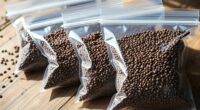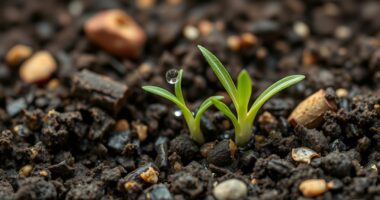To care for your chia plant, make sure you water it consistently so the soil stays moist but not waterlogged. Provide at least 4-6 hours of direct sunlight daily, either outdoors or near a south-facing window indoors. Fertilize with a balanced, organic feed every few weeks during active growth, but avoid overdoing it. Keeping these basics in check will promote lush growth and resilience—keep going to discover more expert tips to optimize your chia’s health.
Key Takeaways
- Provide 4-6 hours of direct sunlight daily, ideally near south-facing windows indoors or outdoors in full sun.
- Water consistently to keep soil moist but avoid waterlogging; test soil moisture regularly.
- Use balanced organic fertilizer every few weeks during the growing season to promote healthy growth.
- Ensure well-draining, organic-rich soil to strengthen plants and prevent pests.
- Water early in the morning to reduce fungal diseases and maintain optimal soil moisture levels.

Are you wondering how to keep your chia plant healthy and thriving? The key lies in understanding its specific needs, especially when it comes to soil health and pest control. Your chia plant depends heavily on the quality of the soil you use. Guaranteeing the soil is rich, well-draining, and full of organic matter will give your plant a strong foundation. Poor soil can lead to weak growth and make your chia more vulnerable to pests. Regularly check the soil’s moisture and amend it with compost to maintain its vitality. Healthy soil not only promotes lush growth but also helps your plant resist pests naturally, reducing the need for chemical interventions. Incorporating the right soil composition can significantly improve your plant’s overall health and yield. Watering plays a crucial role in your chia plant’s health. You want to keep the soil consistently moist but not waterlogged. Overwatering can drown the roots and cause rot, while underwatering stresses the plant and stunts its growth. Use your finger to test the soil; if the top inch feels dry, it’s time to water. Early morning watering is ideal, allowing excess moisture to evaporate during the day, which also helps prevent fungal diseases. Be cautious of pests like fungus gnats that thrive in overly moist conditions. Proper watering routines can help keep these pests at bay and prevent infestations from taking hold.
Healthy, organic soil supports thriving chia plants and naturally wards off pests.
Sunlight is another essential factor. Your chia plant loves full sun, requiring at least 4-6 hours of direct sunlight daily. If you’re growing it indoors, place it near a south-facing window or use grow lights to mimic natural sunlight. Adequate sunlight encourages vigorous growth and seed production. Without enough light, your chia may become leggy and weak, making it more susceptible to pests and diseases. When outdoors, ensure your plant is not shaded by larger plants or structures, and consider rotating it periodically to promote even growth.
Fertilization is equally important for healthy development. Use a balanced, organic fertilizer every few weeks during the growing season. Too much fertilizer can cause excessive leaf growth at the expense of seed production, so moderation is key. Additionally, healthy, well-fed plants are less likely to attract pests, as they are more resilient. Keep an eye out for common pests such as aphids or spider mites, which can be deterred with natural remedies like neem oil or insecticidal soap. Regularly inspecting your plant and maintaining soil health creates a strong defense against pests and guarantees your chia remains vibrant and productive.
Frequently Asked Questions
How Do I Propagate Chia Plants From Cuttings?
To propagate chia plants from cuttings, you should focus on effective propagation methods and proper cutting techniques. Start by selecting healthy stems and cut just below a node. Remove lower leaves and dip the cut end in rooting hormone if desired. Place the cutting in moist soil or water, ensuring it stays moist but not waterlogged. With patience, roots will develop, allowing you to transplant your new chia plant successfully.
What Pests Commonly Affect Chia Plants?
You might encounter pests like aphids, spider mites, or fungus gnats on your chia plants. Pest identification helps you target the problem effectively. For organic pest control, try spraying a mixture of neem oil or insecticidal soap, which are safe and eco-friendly options. Regularly inspect your plants for signs of pests and act promptly to keep your chia healthy and thriving without harmful chemicals.
Can Chia Plants Tolerate Drought Conditions?
Think of chia plants as tiny desert explorers, built for drought resilience. They can tolerate some water stress, but they still need occasional watering to thrive. While they handle dry spells better than most plants, prolonged drought conditions can weaken them. To keep your chia healthy, provide deep watering during dry periods and guarantee good soil drainage—this helps them bounce back from water stress and stay resilient against drought.
How Do I Prevent Mold on Chia Seeds?
To prevent mold on your chia seeds, focus on proper seed storage and mold prevention techniques. Keep seeds in an airtight container in a cool, dry place with low humidity. Avoid moisture buildup, which encourages mold growth. Always guarantee seeds are completely dry before storing, and consider adding a silica gel packet to absorb excess moisture. Regularly check stored seeds and discard any that show signs of mold to keep your supply fresh.
What Are Signs of Nutrient Deficiencies in Chia Plants?
Imagine your chia plant as a musician needing the right tune; if it’s out of harmony, it signals a nutrient deficiency. Look for plant symptoms like yellowing leaves, stunted growth, or pale new shoots. These signs indicate your plant isn’t getting essential nutrients. Pay attention to these cues, and adjust your fertilization routine accordingly. Recognizing these signs helps make sure your chia stays healthy and vibrant, just like a well-tuned instrument.
Conclusion
To keep your chia plant thriving, remember that proper watering, sunlight, and fertilization are key. Think of it like a small, green friend that needs just the right care to flourish. If you give it consistent attention, you’ll see it grow lush and healthy. Visualize a tiny garden where each element works together—water keeps it lively, sunlight energizes it, and nutrients feed its growth. With patience and care, your chia plant will reward you with vibrant greenery.








